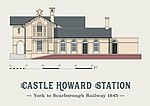Kirkham, North Yorkshire

Kirkham is a village in the civil parish of Westow, in North Yorkshire, England, close to Malton, situated in the Howardian Hills alongside the River Derwent, and is notable for the nearby ruins of Kirkham Priory, an Augustinian establishment. Kirkham was historically an extra parochial area in the East Riding of Yorkshire. It became a civil parish in 1866. On 1 April 1935 the civil parish was abolished and merged into the civil parish of Firby. In 1931 the parish had a population of 31.In 1974 it was transferred to the new county of North Yorkshire. From 1974 to 2023 it was a part of the Ryedale district and when the parish of Firby was abolished it joined the parish of Westow. Kirkham was served by Kirkham Abbey railway station on the York to Scarborough Line between 1845 and 1930.John Oxley (1785-1828), an explorer of south-east Australia, was born here.
Excerpt from the Wikipedia article Kirkham, North Yorkshire (License: CC BY-SA 3.0, Authors, Images).Kirkham, North Yorkshire
Geographical coordinates (GPS) Address Nearby Places Show on map
Geographical coordinates (GPS)
| Latitude | Longitude |
|---|---|
| N 54.08372 ° | E -0.87184 ° |
Address
YO60 7JS
England, United Kingdom
Open on Google Maps










